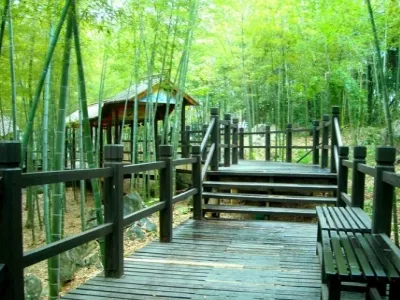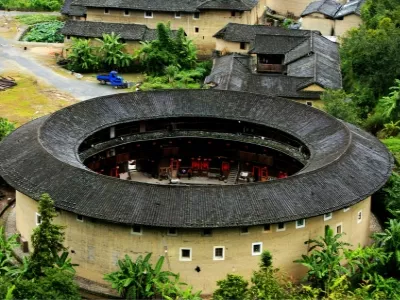“Leaving the city walls brings mountain vistas, dwelling in downtown offers forests and springs” - this describes Zhenjiang perfectly. With over 3,000 years of history illustrated in magnificent landscapes, every corner of this small city tells a story, from White Snake flooding Jinshan Temple to Liu Bei’s marriage proposal at Ganlu Temple. The Second Opium War opened Zhenjiang’s gates, adding vivid color to her rich tapestry.
Dashi Kou is the bustling city center, convenient for transportation, shopping and entertainment. Each of Zhenjiang's hills harbors history and scenery. Jinshan Temple and Su Shi’s "Water Song" reveal Jinshan's lore. Ganlu Temple hosted Liu Bei’s famed marriage proposal on Beigu Hill during the Three Kingdoms era. And the calligraphy masterpiece “Inscription on a Crane’s Call” graces Jiao Hill. Buddhist holy mountain Baohua Shan and Taoist first blessed land Maoshan complete the trinity.
As one of the first treaty ports, Xijin Ferry Wharf still conveys Zhenjiang’s modern history. Mountains, temples, tales - Zhenjiang’s landscapes and legends invite immersive exploration.
Maoshan Xiangqi Temple Fair
Maoshan Temple Fair, Zhenjiang
Spanning nearly three months from late December to mid-March, the Maoshan Temple Fair immerses visitors in the mysteries of the holy mountain.
Pilgrims ascend Maoshan's peaks to light incense at its many temples and shrines. Marvel at the natural scenery, three legendary rock formations, and the mountain's religious heritage.
Folk troupes perform operas, dances, and magic. Artisans sell amulets and charms. Enjoy local snacks like candied haws and peanut cake.
As one of China's four most famous temple fairs, Maoshan combines solemn rituals with festive joy. Join processions bearing the palanquin of Lord Mao, the mountain's patron deity. Experience an ancient spiritual tradition continuing through the centuries.
Zhenjiang Plum and Cherry Blossom Festival
Maoshan Temple Fair, Zhenjiang
Spanning nearly three months from late December to mid-March, the Maoshan Temple Fair immerses visitors in the mysteries of the holy mountain.
Pilgrims ascend Maoshan's peaks to light incense at its many temples and shrines. Marvel at the natural scenery, three legendary rock formations, and the mountain's religious heritage.
Folk troupes perform operas, dances, and magic. Artisans sell amulets and charms. Enjoy local snacks like candied haws and peanut cake.
As one of China's four most famous temple fairs, Maoshan combines solemn rituals with festive joy. Join processions bearing the palanquin of Lord Mao, the mountain's patron deity. Experience an ancient spiritual tradition continuing through the centuries.
Take a stroll around the old house in Zhenjiang
Beyond Jinshan Temple and Xijindu, Zhenjiang's history runs deep, waiting to captivate you. At the Dream Brook Garden, poet Shen Kuo penned his famous Dream Brook Essays. Stroll tree-lined avenues like Boxian Road and Jingji Road to discover the city's cosmopolitan past in Sino-Western hybrid mansions. Pass the former British Consulate, Guangzhou Association, Red Swastika Society's Jiangsu headquarters, Zhenjiang Chamber of Commerce and May 30th Lecture Hall, Jinshan Hotel, Jiangnan Hotel, Jiang Huai-ren's clinic, Tu Family Villa, old Post Office, Shaozong Book Repository, and more - each speaking to generations of movers and shakers who've left their mark here. Tour the centuries-old Hengshun Vinegar Factory, tasting the legendary vinegar that makes Zhenjiang famous. And as you depart, marvel at the magnificent Runyang Bridge spanning the Yangtze, a fitting testament to this river port's enduring spirit. From faded heritage plaques to bustling shopfronts, Zhenjiang's winding lanes and sprawling bridges spin many a captivating yarn. Come stroll this livable history book and savor the stories it tells.
Best Travel Time
Spring and autumn are the best seasons for tourism in Zhenjiang. Spring and autumn have moderate temperatures, making them the most suitable for tourism. This is also the time of the year when Zhenjiang holds the most various festivals. On December 31st of each year, there is a New Year prayer and bell striking event at Jinshan Park in Zhenjiang; In March and April, it is the season when cherry blossoms bloom in Baotashan Park in Zhenjiang. There is a large-scale Yulan Flower Appreciation Festival at Baohua Mountain Fair and a grand Xiangqi Temple Fair at Jurong Maoshan. Around the Mid Autumn Festival, the Jiaoshan Park Osmanthus Festival and the Zhenjiang Golden Autumn Food Festival were held one after another, adding a strong festive atmosphere to the autumn in Zhenjiang.Arriving at the airport
Zhenjiang currently does not have its own airport. The closest is Changzhou Benniu Airport, but it is generally more convenient to travel from Nanjing Lukou Airport to Zhenjiang.
Direct airport shuttle buses operate between Nanjing Lukou Airport and Zhenjiang, taking around 1.5 hours and costing ¥60. A taxi from the airport to Zhenjiang is around ¥260 (negotiable price).
Airport Shuttle Schedule:
From Airport - 10:30, 12:00, 13:30, 14:35, 15:30, 16:30, 18:05, 19:30, 21:00, 22:30, 5:30, 7:00, 8:00, 9:30, 11:00, 12:30, 14:00, 15:30, 17:00, 18:30
From Zhenjiang South Square - 5:30, 7:00, 8:00, 9:30, 11:00, 12:30, 14:00, 15:30, 17:00, 18:30
Contact: 0511-85233898 (Zhenjiang)
On arrival, take bus 53 from Zhenjiang South Square Station to reach the city center. With regular schedules, the airport shuttle provides a direct public transport option between Nanjing Airport and Zhenjiang.
Ships
There is a ferry service operating between Zhenjiang and Yangzhou across the Yangtze River. The Zhenyang Ferry runs from Xijin Ferry Terminal in Zhenjiang West to Guazhou Ferry Terminal in Yangzhou.
Although the Zhenyang Bridge provides faster road connections, the ferry offers a nice experience of crossing the mighty Yangtze. Fares are affordable at ¥3 for passengers, ¥5 with bikes/motorbikes. The 10-minute crossing has frequent departures every few minutes and operates 24/7.
Location: Xijin Ferry Terminal is on the northwest side of Runzhou Lu in Zhenjiang West.
Hours: 24 hours daily
Contact: 0511-85623370
On arrival, take bus 10, 36 or 115 from Ferry Terminal Station (last stop) to reach the city center. The regular Zhenyang Ferry schedule makes it easy to hop across the Yangtze between Zhenjiang and Yangzhou.
Self driving
Zhenjiang is connected by major national highways and expressways.
National Highway 312 starts in Shanghai, passes Suzhou, Wuxi, Changzhou and ends in Zhenjiang, continuing northwest all the way to the Khorgas border crossing in Xinjiang.
National Highway 104 runs from Beijing south through Zhenjiang and ends in Fuzhou.
The Shanghai-Nanjing Expressway (G42) goes through Jurong, Zhenjiang, Dantu and Danyang, linking Shanghai and Nanjing. The Zhenjiang spur line (S86) connects to the city center.
Provincial Highway S338 starts in Zhenjiang, passes Changzhou, Jiangyin, Zhangjiagang, Changshu and Taicang before ending at the northern end of the Shanghai-Taicang Highway on the border of Shanghai and Taicang.
The Yangli Expressway (G4011) runs through Zhenjiang, crossing the Yangtze on the Runyang Bridge to connect with the Beijing-Shanghai Expressway (G2) towards Beijing in the north, and seamlessly joins the Nanjing-Hangzhou Expressway (G25) south towards Jintan and Liyang.
Key routes:
Changzhou to Zhenjiang: Longcheng Elevated Road - Longjiang Elevated Road - Longjiang North Road - Shanghai-Chengdu Expressway
Yangzhou to Zhenjiang: Yangzi Middle Road - Nanjing-Yang Expressway - Yangli Expressway - North Fu Road
Nanjing to Zhenjiang: Ring Road - Maqun Junction - Shanghai-Chengdu Expressway - S86 turn slightly right - Zhenjiang Junction straight
With intersections of major highways and expressways, Zhenjiang enjoys convenient road connections to surrounding cities.







